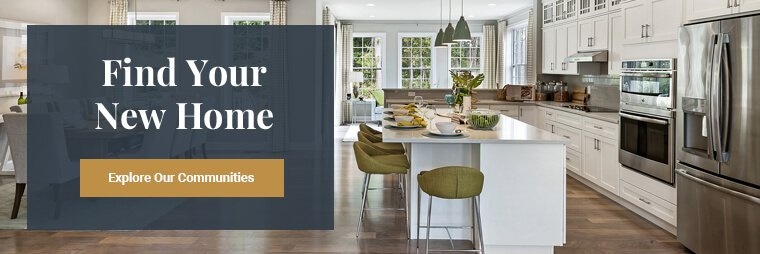Is your home too cold during the winter and too warm during the summer? If your house isn’t energy efficient, your heating, ventilation and air-conditioning (HVAC) system will struggle to maintain a comfortable temperature. Drafty windows, insufficient insulation, appliances that use too much electricity and other issues may make your home less efficient and add hundreds or thousands of dollars to your utility bills every year.
Saving money and improving your home’s energy efficiency can be as simple as making a few changes or repairs, updating old appliances with more efficient models, or even better, buying a brand new home with energy efficient features. When you evaluate your home’s energy efficiency, consider these factors.
Air Leaks
Tiny openings in your home allow cooled or warmed air to escape. Although doors and windows are often to blame for drafts, they aren’t the only causes of air leaks. Leaks can occur around pipes, wires and air ducts or around floor joists and eaves. Fireplaces, electrical outlets and vents can also allow air to enter your home.
Although air leaks may be unavoidable in older homes, new houses are built using tight construction techniques to prevent leaks. At Blenheim Homes, we use energy efficient DuPont Tyvek HomeWrap when building the houses in our communities. The wrap prevents drafts, which not only makes your HVAC system more effective but also prevents water damage and mold formation. Ducts are tightly sealed to prevent air from entering through spaces around the ducts.
Peel back the layers of one of our homes using our interactive home cutaway to learn more about the materials used in making your home energy efficient.
Windows
Windows play an important role in keeping your home comfortable. In fact, 25 to 30 percent of residential heating and cooling energy use can be attributed to heat gain or loss through windows, according to the U.S. Department of Energy. Installing double pane windows offer a simple way to improve the energy efficiency of a home. The windows consist of two panes of glass separated by a layer of air. The air helps insulate the windows, preventing heat loss.
Our homes feature Low E Silver Line windows that are double-insulated to reflect heat away from your home outdoors and trap it indoors, keeping you cool in the summer and warm in the winter. The reflection reduces your heating and cooling costs while still allowing in an abundance of natural light. Double pane windows also reduce noise transmission from outdoors, prevent condensation and increase the value of your home.
Insulation
You can expect a bigger utility bill if your home is poorly insulated. Insulation is measured by the R-value, a factor assigned based on the ability of the insulation to prevent heat flow between warmer and colder areas. The higher the R-value, the better. Our homes feature R-38 insulation in the attics to help keep your living space at a consistent temperature. This reduces your energy costs by minimizing heat flow into your home, which helps prevent temperature changes inside.
Construction techniques also affect the type of insulation that can be used. We use 2x6 construction to build the walls of our homes, which not only produces a stronger structure, but allows us to add thicker insulation, increasing the overall R-value of the home and offering more energy-saving protection from the elements and outside sound.
Basements can also often be chilly even though the rest of the house is comfortable. Blanket wall insulation added to basement walls offers a continuous barrier of insulation keeps elements out of your basement and maintains a consistent temperature below ground.
Climate Control
Of course, an efficient HVAC system is of paramount importance when talking about energy efficiency. The Carrier Home Comfort Series HVAC System installed in Blenheim homes offers a 92.1 percent heating efficiency rating. The system is designed to run quietly while reducing temperature swings and improving dehumidification.
Combined with tightly sealed duct work, wasted energy is minimized by ensuring airflow is delivered to the areas you need, leading to less loss of conditioned air.
Also, (thanks to smart technology) it’s now possible to control your HVAC system when you’re not home. Depending on your thermostat, a simple app can allow you to lower or raise the temperature while you’re at work or the mall. You can also program the system to change the temperature automatically depending on the time of day.
Some smart thermostats even learn your preferences. After observing your heating and cooling preferences for a few days, the thermostats automatically lower the temperature when you usually go to bed and increase the temperature shortly before you get up in the morning or arrive home from work.
Other Features That Improve Energy Efficiency
These home features will improve your home’s energy efficiency:
- ENERGY STAR Appliances: ENERGY STAR appliances meet or exceed federal standards for quality and efficiency and help you save on your utility bills. They include water heaters, dishwashers, microwaves, washers, dryers, ranges and refrigerators.
- Ridge Vents: A continuous ridge vent along the roof line of your house prevents temperature extremes in your attic, which can help you control your energy costs. A ridge vent also allows damp, warm air to escape, keeping your roof in good condition.
- Energy-Efficient Plumbing Systems: Efficient plumbing systems, like the Viega ManaBloc system Blenheim Homes uses, offer several benefits for homeowners. Efficient systems reduce the time it takes to heat water, which means you waste less water. Other benefits include standardized water pressure throughout your house and individual fixture control.
- Landscaping: Adding shade trees to your lot can keep your home cooler in the summer. Although it will take a few years for the trees to offer adequate shade, investing in an upgraded landscaping package offers benefits that last for years. Plant and flower species that aren’t native to our area may require more care and more frequent watering. You’ll save money and reduce water waste when you choose native plants, flowers, shrubs and trees.
Your new home won’t seem quite as appealing if your utility bills are high, or you can’t stop shivering during the winter months due to poor insulation or an ineffective heating system. Fortunately, you can avoid these issues by purchasing a home in one of the Delaware communities designed by Blenheim Homes. Appearance isn’t the only factor we consider when design and build our homes. Every dwelling is constructed using the latest energy-efficient techniques to improve your comfort and save you money.





